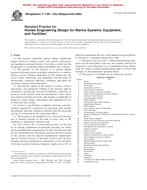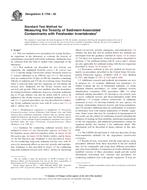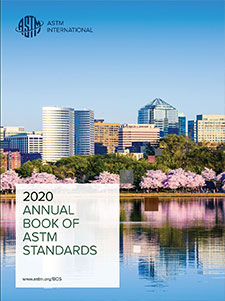
ASTM F1166-95a(2006)
1.1 This practice establishes general human engineering design criteria for marine vessels, and systems, subsystems, and equipment contained therein. It provides a useful tool for the designer to incorporate human capabilities into a design.
1.2 The purpose of this practice is to present human engineering design criteria, principles, and practices to achieve mission success through integration of the human into the vessel system, subsystem, and equipment with the goals of effectiveness, simplicity, efficiency, reliability, and safety for operation, training, and maintenance.
1.3 This practice applies to the design of vessels, systems, subsystems, and equipment. Nothing in this practice shall be construed as limiting the selection of hardware, materials, or processes to the specific items described herein. Unless otherwise stated in specific provisions, this practice is applicable to design of vessel systems, subsystems, and equipment for use by both men and women.
1.4 Copies of specifications, standards, drawings, and publications required by contractors in connection with specific procurement functions should be obtained from the procuring activity or as directed by the contracting officer.
1.5 This practice is not intended to be a criterion for limiting use of material already in the field in areas such as lift repetition or temperature exposure time.
1.6 Force Limits – If it is known that an item is to be used by an already established occupational specialty, for which physical qualification requirements for entry into that specialty are also established, any discrepancy between the force criteria of this practice and the physical qualification requirements shall be resolved in favor of the latter. In this event, the least stringent physical qualification requirement of all specialties which may operate, maintain, transport, supply, move, lift, or otherwise manipulate the item, in the manner being considered, is selected as a maximum design force limit.
1.7 Manufacturing Tolerances – When manufacturing tolerances are not perceptible to the user, this practice shall not be construed as preventing the use of components whose dimensions are within a normal manufacturing upper or lower limit tolerance of the dimensions specified herein.
1.8 This practice is divided into the following sections:
| TABLE OF CONTENTS | |
| Section | Title |
| 1 | Scope |
| 2 | Referenced Documents |
| 3 | Terminology |
| 4 | Significance and Use |
| 5 | Control/Display Integration |
| 6 | Visual Displays, General Information |
| 7 | Location and Arrangement of Visual Displays |
| 8 | Coding of Visual Displays |
| 9 | Transilluminated Displays |
| 10 | Scale Indicators |
| 11 | Cathode Ray Tube (CRT) Displays |
| 12 | Large-Screen Displays |
| 13 | Other Displays |
| 14 | Audio Displays, General Information |
| 15 | Audio Warnings |
| 16 | Characteristics of Audible Alarms |
| 17 | Signal Characteristics in Relation to Operational Conditions and Objectives |
| 18 | Verbal Warning Signals |
| 19 | Controls for Audio Warning and Caution Devices |
| 20 | Speech Transmission Equipment |
| 21 | Controls, General Information |
| 22 | Arrangement and Grouping of Controls |
| 23 | Coding of Controls |
| 24 | Rotary Controls |
| 25 | Discrete Linear Controls |
| 26 | Continuous Adjustment Linear Controls |
| 27 | General Requirements for Labeling |
| 28 | Label Content |
| 29 | Specific Requirements by Label Type |
| 30 | Anthropometry |
| 31 | Workspace Design Requirements |
| 32 | Environment |
| 33 | Maintainability |
| 34 | Accessibility |
| 35 | Cases |
| 36 | Lubrication |
| 37 | Fasteners |
| 38 | Unit Design for Efficient Manual Handling |
| 39 | Handwheel Torque |
| 40 | Equipment Mounting |
| 41 | Conductors |
| 42 | Connectors |
| 43 | Electrical Wires and Cables |
| 44 | Test Points |
| 45 | Test Equipment |
| 46 | Failure Indications and Fuse Requirements |
| 47 | Hydraulic Systems |
| 48 | Design of Equipment For Remote Handling |
| 49 | Small Systems and Equipment |
| 50 | Operational and Maintenance Vehicles |
| 51 | Hazards and Safety |
| 52 | User-Computer Interface |
| 53 | Data Display |
| 54 | Text/Program Editing |
| 55 | Audio Displays, Interface |
| 56 | Interactive Control |
| Figure | Title |
| 1 | Angle of Incidence |
| 2 | Example of Display/Equipment Relationship in Main Propulsion Engine Room with Two Medium Speed Diesel Engines |
| 3 | Example of Control/Display/Equipment Relationship in Auxiliary Machinery Space with Two Ship Service Generators |
| 4 | Example of Control/Display/Equipment Relationship in Machinery Space with Pump, Motor Controller, and Gage Board Located at Vertical Beam |
| 5 | CHT Pump Room with Various Options for Locating the Two Motor Controllers and Their Corresponding Gage Boards Given the Location of the Two Pumps |
| 6 | Preferred and Acceptable Alternatives for Multiple Row/Column Display and Control Arrangement |
| 7 | Vertical and Horizontal Visual Field |
| 8 | Lines of Sight |
| 9 | Scale of Markings |
| 10 | Scale Graduation, Pointer Position, and Scale Numbering Alternatives |
| 11 | Fixed-Scale Azimuth Dials |
| 12 | Shape and Color Coding Operating Ranges |
| 13 | Zero Position and Pointer Movement for Circular Dial Displays |
| 14 | Aligned Pointers for Rapid Check Readings |
| 15 | Relative Position of Scale Marks, Numerals, and Pointers on Circular Dials |
| 16 | Relative Position of Scale Marks, Numerals, and Pointers on Arcs and Circular Dials |
| 17 | Drum-Type Counter Design |
| 18 | Acceptable Alarm Types for Emergency and Primary Alarms |
| 19 | Control Motion Expectancy |
| 20 | Foot-Operated Switches |
| 21 | Pedals |
| 22 | Foot-Operated Controls |
| 23 | Leg Strength at Various Knee and Thigh Angles |
| 24 | Rotary Selector Controls |
| 25 | Rotating Knob Separation |
| 26 | Keylock Criteria |
| 27 | Keylock Switch Criteria |
| 28 | Thumbwheel Orientation and Movement |
| 29 | Discrete Thumbwheel Control |
| 30 | Knobs |
| 31 | Recommended Knob Shapes |
| 32 | Easily Recognizable Knob Shapes |
| 33 | Ganged Knobs |
| 34 | Thumbwheel Adjustment Controls |
| 35 | Cranks |
| 36 | Proper Mounting of Rapidly Operated Cranks |
| 37 | Handwheels |
| 38 | Recommended Mounting Heights for Valve Handwheels |
| 39 | Reaching Limits for Bending, Squatting, or Standing on Ladders |
| 40 | Pushbutton Switches |
| 41 | Toggle Switches |
| 42 | Toggle Switch Orientation for “ON” |
| 43 | Legend Switch |
| 44 | Rocker Switches |
| 45 | Slide Switches |
| 46 | Push-Pull Controls |
| 47 | Lever |
| 48 | Slide Levers |
| 49 | Isotonic Joysticks |
| 50 | Ball Controls |
| 51 | Independent Symbols |
| 52 | Label Specifications |
| 53 | Standing Body Dimensions |
| 54 | Seated Body Dimensions |
| 55 | Depth and Breadth Dimensions |
| 56 | Circumferences and Surface Dimensions |
| 57 | Hand and Foot Dimensions |
| 58 | Head and Face Dimensions |
| 59 | Anthropometric Data for Body Positions Involved in Work Activities |
| 60 | 95th Percentile Gloved-Hand Dimensions (Male) |
| 61 | Helmet Dimensions |
| 62 | Aircrewman’s Helmet (Size Extra Large) |
| 63 | Range of Human Motion |
| 64 | Mobile Workspace Dimensions |
| 65 | Standing Workspace Dimensions-Cabinets and Electrical Equipment Racks |
| 66 | Standing Workspace Dimension-CRTs and Table |
| 67 | Standing Workspace Dimensions-Consoles and Work Benches |
| 68 | Standing Workspace for Typical Work Positions |
| 69 | Display (Top) and Control (Bottom) Locations for Standing Crew Work Stations |
| 70 | Seated Workspace Dimensions |
| 71 | Dimensions for Single or Multiple Personnel at a Table or Other Duty Station Not Requiring a Desk |
| 72 | Seating at CRT-Type Work Stations |
| 73 | Swing-Away Seat for Short-Term Operations |
| 74 | Standard Console Dimensions Key |
| 75 | Example of One- or Two-Tier Wrap-Around Console |
| 76 | Examples of Three-Tier Consoles |
| 77 | Example of a Desk Top Console |
| 78 | Preferred Viewing Area |
| 79 | Seated Optimum Manual Control Space |
| 80 | Type of Ladder, Stair, or Ramp to be Used in Relation to Angle of Ascent |
| 81 | Stair Dimensions |
| 82 | Incline-Ladder Dimensions |
| 83 | Vertical-Ladder Dimensions |
| 84 | Well-Designed Work Platform |
| 85 | Door Dimensions |
| 86 | Hatches Mounted Overhead |
| 87 | Hatches Mounted on Vertical Walls |
| 88 | Hatch Dimensions |
| 89 | Walkway and Passageway Dimensions |
| 90 | Effective Temperature Scale |
| 91 | Windchill Chart |
| 92 | Equivalent Chill Temperature |
| 93 | Ventilation Requirements |
| 94 | Workspace Reflectance Values |
| 95 | Permissible Distance Between a Speaker and Listener’s for Specified Voice Levels and Ambient Noise Levels |
| 96 | Range of Acceptable Reverberation Time |
| 97 | Vibration Exposure Criteria for Longitudinal (Upper Figure) and Transverse (Lower Figure) Directions with Respect to Body Axis |
| 98 | The 90 % Motion Sickness Protection Limits for Human Exposure to Very Low Frequency Vibration |
| 99 | Standing, Lateral Reach (Preferred Arm) |
| 100 | Seated, Forward Reach (Both Arms) |
| 101 | Crosslegged Seated, Forward Reach (Both Arms) |
| 102 | Standing, Forward Reach (Both Arms) |
| 103 | Standing, Forward Reach (Preferred Arm) |
| 104 | Access Opening Dimensions |
| 105 | Minimal Two-Hand and Finger Access |
| 106 | Covers and Accesses |
| 107 | Covers and Cases |
| 108 | Examples of Push-Pull Forces |
| 109 | Minimum Handle Dimensions |
| 110 | Handwheel Torque |
| 111 | Methods of Identifying Plugs and Receptacles to Prevent Mismatching |
| 112 | Cable Arrangements |
| 113 | Suggested Cable Arrangement in Junction Box for Easy Checking |
| 114 | Preformed Cables |
| 115 | Fluid Line Connector Recommendations |
| 116 | Anatomical Limits on Axially Symmetrical Ocular Metal Part |
| 117 | Mounting Heights for Common Electrical Fixtures |
| 118 | Required Distance Between Hazard and Barrier |
| Table | Title |
| 1 | Metric Equivalents, Abbreviations, and Prefixes |
| 2 | Coding of Simple Indicator Lights |
| 3 | Application of Various Types of Mechanical Displays |
| 4 | Character Sizes for Mechanical Counters |
| 5 | Group Viewing of Optical Projection Displays |
| 6 | Range Ring Values |
| 7 | Functional Evaluation of Audio Signals |
| 8 | Intelligibility Criteria for Voice Communications Systems |
| 9 | Control Selection Criteria |
| 10 | Recommended Manual Controls |
| 11 | Conventional Control Movement Stereotypes |
| 12 | Minimum Separation Distances for Controls |
| 13 | Advantages and Disadvantages of Various Types of Coding |
| 14 | Recommended Control Colors (FED-STD-595) |
| 15 | Knob Detentes Placement |
| 16 | Keyboards, Inch-pound Units |
| 17 | Keyboards, SI Units |
| 18 | Limiting Dimensions for Free-Moving X–Y Controller |
| 19 | Arm Strength |
| 20 | Hand and Thumb-Finger Strength |
| 21 | Character Size Versus Luminance |
| 22 | Anthropometric Data |
| 23 | Range of Human Motion |
| 24 | Mobile Work Space Dimensions |
| 25 | Standing Work Space Dimensions for Work Clearances |
| 26 | Seated Work Space Dimensions |
| 27 | Standard Console Dimensions |
| 28 | Human Performance Effects at Various Effective Temperatures |
| 29 | Physical and Perceptual Responses to Various Temperatures |
| 30 | Temperature and Its Effect on the Comfort of the Extremities |
| 31 | Human Reaction to Windchill |
| 32 | Specific Task Illumination Requirements |
| 33 | Recommendations for Display Lighting |
| 34 | Low-Frequency and Infrasonic Noise Limits to Prevent Ear Injury |
| 35 | Sound Exposure to Avoid Deafness |
| 36 | Maximum Permissible Sound Pressure Level |
| 37 | OSHA Permissible Daily Noise |
| 38 | Effects of Noise on Human Performance |
| 39 | Effects of High-Level Noise on Human Performance |
| 40 | Upper Noise Limits Recommended for Military Facilities |
| 41 | Comfort Limits for Noise by Octave Band |
| 42 | Noxious Exhaust Products of Engine Fuels |
| 43 | Design Weight Limits |
| 44 | Static Muscle Strength Data |
| 45 | Weight and Dimensions of Portable Test Equipment |
| 46 | General Comparison Fuses and Circuit Breakers |
| 47 | Recommended Clearances Around Equipment Operator’s Station to Accommodate 95th Percentile Male Dressed in Arctic Clothing. Operator Seat in Rear Most Position |
| 48 | Temperature Limits |
| 49 | Shock Current Intensities and Their Probable Effects |
| 50 | Allowable Exposure Limits to Some Toxic Gases |
| 51 | System Response Times |
Product Details
- Published:
- 06/01/2006
- Number of Pages:
- 155
- File Size:
- 1 file , 2.9 MB

